TUESDAY
OCTOBER 30 - 2018
Friends
reunited
I went over to
Nore Barn at about 11.30am this morning to check on
the Spotted Redshank which I saw for the first time
this autumn yesterday. I did not have to go far as the
bird was in the fresh water stream with its long
standing feeding companion, the colour-ringed
Greenshank (G+GL). The Common Redshank was also
present in the stream area, but feeding quite
separately.

I think the Spotted
Redshank and the Greenshank have been feeding together
in this stream for almost 10 years, which includes a
few years before the Greenshank was ringed by Pete
Potts in September 2014. I recall Pete suggesting he
might ring the Spotted Redshank, but this never
happened. Of course, they go their separate ways for
breeding, but always return to this stream in autumn
which must have a rich source of food. I wonder if
they roost together on Thorney Island?
Here's
a couple of shots of the Spotted Redshank from today's
visit
and a video clip of
the Spotted Redshank feeding in the stream . . .
https://youtu.be/wK7pCdWhhzs
MONDAY
OCTOBER 29 - 2018
Spotted
Redshank returns!
I went over to
Nore Barn at about 11.30am this morning with my
grandson Joe who we were looking after as his school
had an inset day following the half term holiday. I
explained to Joe that I was not too hopeful about
seeing the famous Spotted Redshank which had been
coming to Nore Barn for the past 14 winters. It was
late, but not too late.
When we got to the end
of Warblington Road we could clearly hear the gentle
grunting of a good number of Brent Geese out in the
bay, mixed in with Wigeon. But our target was the
stream where we saw a Common Redshank feeding, but
nothing else at first.
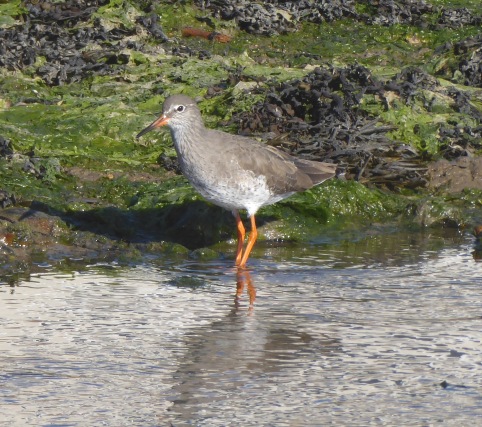
But wait! There was
another bird in the stream, probably the regular
colour-ringed Greenshank, I thought. Then Joe noticed
its red legs and, yes, on closer inspection there was
no mistaking the familiar appearance and feeding
action of our Spotted Redshank, looking as sprightly
as ever, despite its advancing years.
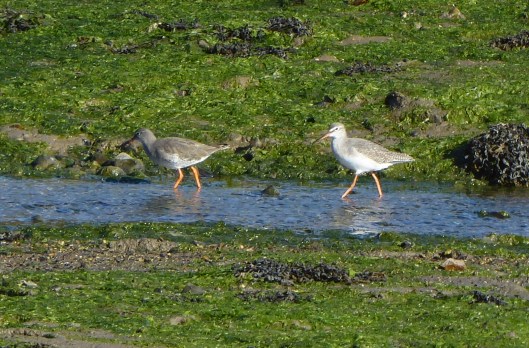
The sun was too bright
for photos from the beach so we went onto the
saltmarshes on the west side of the stream from where
we both had cracking views of the Spotted Redshank
feeding in the stream with the Common Redshank. The
regular colour-ringed Greenshank (G+GL) was not
present. I gave Joe my spare camera, which he is used
to using, and we both enjoyed taking photos and videos
over a period of several minutes with the Spotted
Redshank typically unfazed by our closeness.

The Spotted Redshank
was a week later than my first sighting last year on
22-Oct and the third latest ever first sighting date;
the other two being over ten years ago on 05-Nov-07
and 08-Nov-08.
Here is a video clip
of the Spotted Redshank feeding today in the stream .
. . https://youtu.be/myrRFTtS8A4
See the special
Spotted Redshank web page for the complete history of
this astonishing bird
Go to . . . Spotted
Redshanks at Nore Barn
Emsworth
Harbour
Peter
Milinets-Raby was up with the sun this morning and
visited Emsworth Harbour from 7am to 8:30am. Very low
tide throughout.
Beacon Square: 15 Brent Geese, 4 Meadow Pipit over, 4
Wigeon, 5 Teal, 1 Grey Plover, 1 Green Woodpecker in
back gardens.
Nore Barn: 28 Black -tailed Godwit, 18 Wigeon, 29
Brent Geese, 6 Shelduck, 11 Teal.
Emsworth Harbour: 7 Lapwing, 4 Greenshank (B//R +
NL//- and G//R + BL//- and RG//- + BY//-), 199 Brent
Geese, 24 Dunlin, 10 Grey Plover, 12 Turnstone, 8
Shelduck, 12 Ringed Plover (-//- + B//NB), 1 Grey
Wagtail, 1 Skylark over.
And the bird of the morning was a female Hen Harrier
seen quartering over the sea marsh heading west and
being mobbed by 2 Carrion Crow. A short lived view,
but a great bird to see.
Owls
on Thorney
Christopher
Evans gets regular sightings of Barn Owl at the end of
Thornham Lane, where the track bends left to meet the
sea wall. It generally flies in from the direction of
The Deeps. This afternoon it was there about 16.30.
Christopher says Short Eared Owls have been less
regular but there was one hunting in the field
opposite the bungalows at about 16.10.
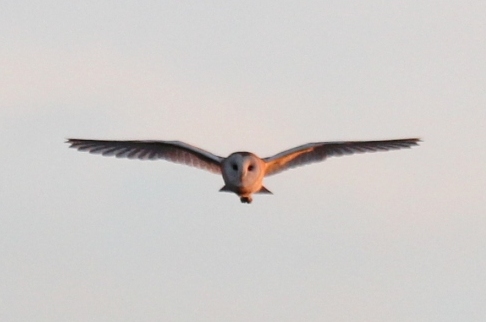
SUNDAY
OCTOBER 28 - 2018
Stansted
fungi
Jill Stanley
sent me photos of the more colourful fungi that she
photographed at Stansted over the past week.
Jill adds . . . "over
the past five years I have been able to identify (to
my satisfaction, at any rate) upwards of 40 different
ones. Stansted is a very prolific place for fungi if
you're prepared to hunt for them in among the leaf
litter, twigs, fallen trees, and brambles."
Well, done Jill.
Golden
Scalycap
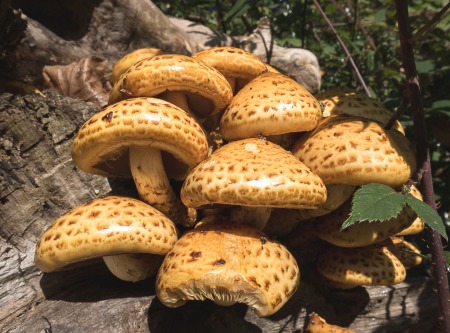
Many-zoned
Polypore
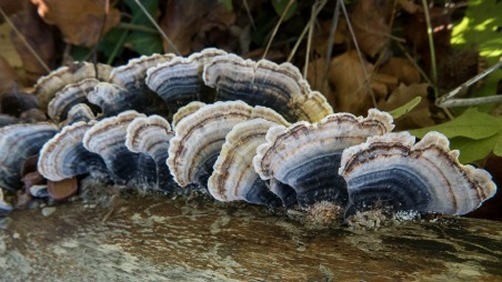
Small
Stagshorn
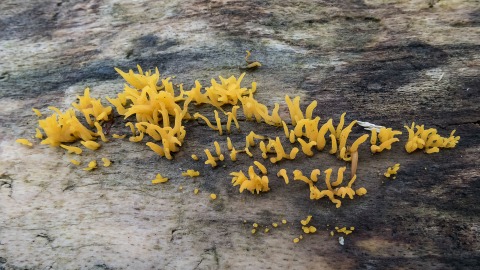
FRIDAY
OCTOBER 26 - 2018
Nore
Barn
10.30 - Tide
falling. Cloudy with light rain. The situation was
much as yesterday with a flock of around 60 Wigeon
snoozing on the edge of the channel with a few
Redshank. They were joined by two Cormorants
stretching their winds after fishing in the main
channel. The photo does not show all the Wigeon!
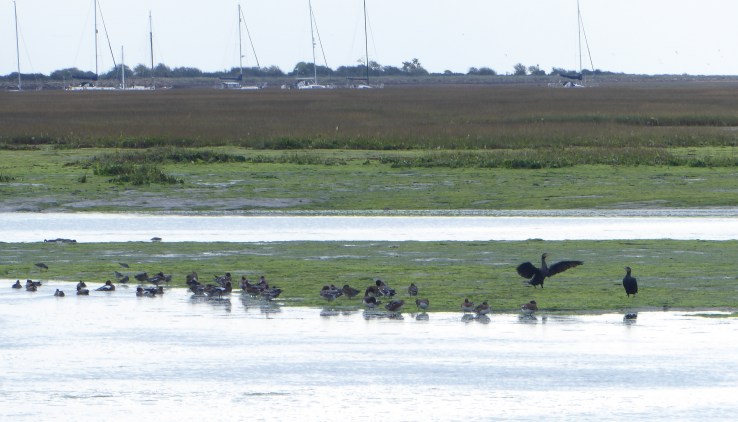
A group of 23
Black-tailed Godwits were feeding on the green algae
covered mudflats - no colour-ringed birds. There were
no Brent Geese today.
Meanwhile, in the stream were a Little Egret and the
two regular small waders, ie the colour-ringed
Greenshank (G+GL) and the Common Redshank, trying
unsuccessfully to pass for a Spotted Redshank.
Rats
in the garden
Last night I
put out a tray of mixed food (sunflower hearts,
Hedgehog food and mealworms) on the patio with the
trail camera pointing at it. Checking the camera this
morning I found two Brown Rats which overall spent a
couple of hours on and off at the food tray with no
sign of any other animal except for next door's cat.
Somewhat surprisingly, the rats only seemed to take
the sunflower hearts from the food tray, ignoring the
Hedgehog food and the mealworms. Tonight I will put
the trail camera out in the same place, but no food
this time!
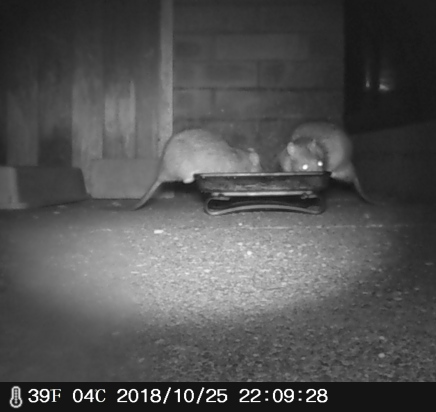
THURSDAY
OCTOBER 25 - 2018
Nore
Barn
I went over to
Nore Barn at 10am this morning to check the harbour on
a rising tide. There was a good number of Wigeon and
Teal in the main channel along with 17 Black-tailed
Godwits busily feeding, but no colour-ringed birds
among them. This photo shows mostly Wigeon.

I also had a few Brent
Geese - my first of the season. There were no
juveniles among them, but it is much too early to
speculate about their breeding success.
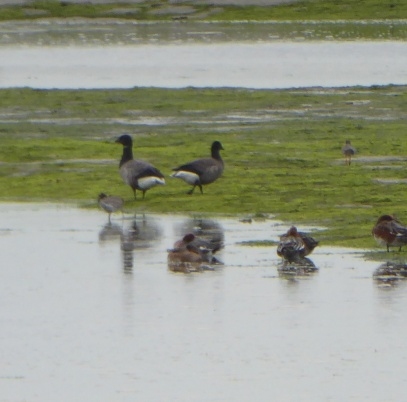
Meanwhile, the only
birds in the stream were the two regulars - the
colour-ringed Greenshank G+GL and the Common
Redshank. As I was watching them, the Greenshank
captured a fish which it proceeded to swallow down
with some difficulty. I don't recall seeing Greenshank
take a fish this size before.
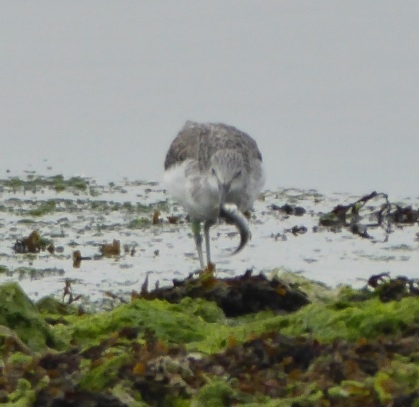
Sadly, there is still
no Spotted Redshank; I am becoming increasingly
pessimistic about its return.
WEDNESDAY
OCTOBER 24 - 2018
Brent
geese are here
Ralph Hollins
reports that there are now plenty of adult Brent Geese
in the local area, but he's only seen two reports of
juvenile Bents. Three juveniles were among a flock of
19 birds on the mud of Hayling Island just east of
Langstone Bridge and one juvenile was seen in
Shoreham.
Susan Kelly reports
the Brent Geese are back in Emsworth Harbour - they
are always a bit later coming in here. Susan saw small
groups of Brent on the last two mornings from Western
Parade, swimming in the creeks on a rising tide,
around 9ish. She said, "One group was close enough
today to see clearly with the naked eye - fourteen or
fifteen. A few peeled off and flew to Hayling, then a
few more came in from the east. When I came back the
tide was up and they were gone, but I could see three
of them flying around between here and Hayling. So
perhaps they are on their way to the upper harbour at
last."
Bats
Susan Kelly
also had five or six bats (probably Pipistrelles)
zipping around her head this evening on the stretch of
footpath between the end of Warblington Ave and the
end of Beach Rd. Susan says this is a particularly
good place to see bats in the early evening.
White
Wagtail?
During a walk
along the west side of Fishbourne creek today at high
tide Sue Thomas spotted on the roof of a house what
she thinks was a White Wagtail (sub species alba). Sue
notes its strikingly marked bib and very pale flanks.
Separating White from Pied Wagtails is not easy and I
have never been confident about doing it. However,
from what I read in the guides Sue's very pale bird
seems to be a fairly good candidate for a White. White
Wagtail is a scarce passage migrant in our area. Other
opinions appreciated.
TUESDAY
OCTOBER 23 - 2018
Nore
Barn
I did my daily
check of the stream at Nore Barn at about 2.30pm for
Spotted Redshank, but there was no sign of it. The
regular colour-ringed Greenshank was present, but
nothing else of interest apart a Mute Swan family with
3 cygnets which could be the family from Peter Pond on
a day's outing.

I had a wander around
the woods where spotted what looked like a Hornet
flying leisurely around the brambles at the far end of
the south path. I waited a while for it to settle to
confirm the identification of Hornet
(Vespa crabro) and to get a
photo and a video clip. Hornet Mimic (Volucella
zonaria) would be the only other possibility for an
insect of this size, but the body shape and pattern on
abdomen rules that out.
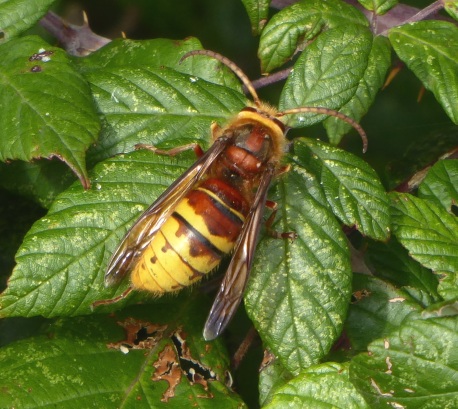
Here is a short video
clip of the Hornet at Nore Barn . . . https://youtu.be/IzljWTKQgmE
Hayling
Oysterbeds
From Nore Barn
I went onto Hayling Island for a nostalgic stroll
around the Oysterbeds where I was a voluntary warden
for several years in the early 2000s. I was pleased to
find the old 'bus shelter' still standing which
provided much needed shelter from the elements during
my sessions there.

I was disappointed to
see the mound behind the shelter totally overgrown
with brambles. That's a pity as it used to have a
variety of interesting wild flowers. The photo shows
the tern rafts laid up on the mound for the winter.
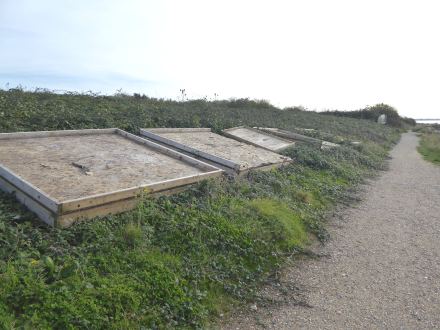
I was interested to
see a new white stone sculpture of an oyster.

Here is a striking
patch of tree-like plants with frost-like decoration
on the east end of the mound.
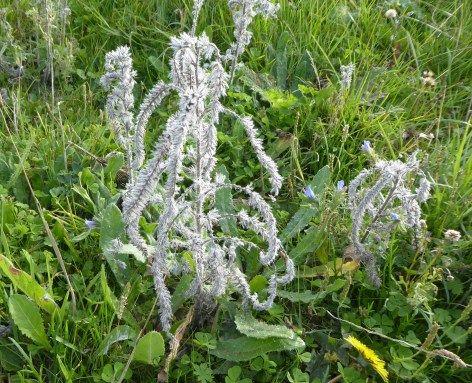
Good to see a healthy
growth of Milk Thistle leaves (Silybum
marianum) in the usual spot at the west end of the
mound.

New interpretation
board showing clearly the footpath right round
Langstone Harbour.
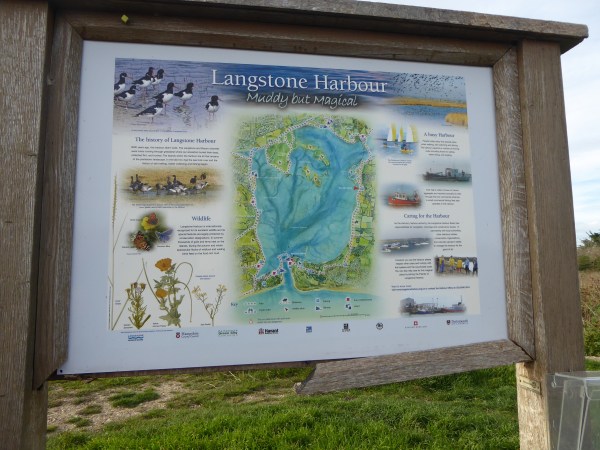
Biodiversity
Survey
Message from
Ray Cobbett: Friends of the Earth has teamed up with
other Emsworth environmentalists to carry out an
online survey of opinions of the state of our local
biodiversity. We will be including feedback form
across the whole borough and especially among those
with a special interest in nature and conservation.
The results will be made public and provide input to
the Local Plan 2036. Could I ask you please to take a
couple of minutes to complete and submit the survey.
All responses are completely anonymised apart from the
area postal code.
Here’s the link
https://docs.google.com/forms/d/e/1FAIpQLScwHnm-ucPA1eQXSkOWDMbubE2ZtjUh2C6EpjKThTC-8EBt8g/viewform?usp=sf_link
MONDAY
OCTOBER 22 - 2018
Nore
Barn
I popped over
to Nore Barn at about 13.30 on a falling tide. The
stream was low, but there was nothing in it when I
arrived. However, the two regulars quickly turned up -
first the Common Redshank, then the colour-ringed
Greenshank (G+GL).
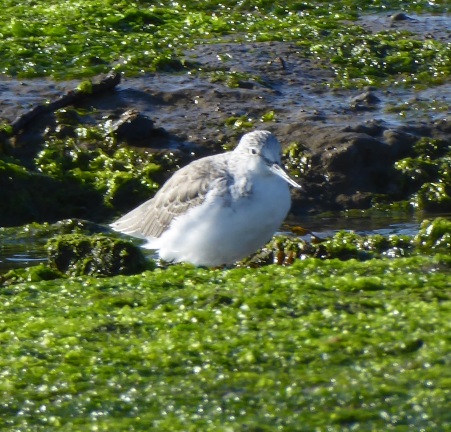
But there is still no
sign of the Spotted Redshank. I first saw it last year
on this day - 22 Oct 2017. I have just checked my
records and this was not, as I previously thought, the
latest date ever as there was a run of 3 years from
2007-08-09 when the Spotted Redshank did not show up
until early November, so there is still time and hope!
Roe
deer swimming
At lunchtime
today Ros Norton saw a Roe Deer swim across the
Thorney Great Deeps from south to north viewed from
west gates. Deer are competent swimmers. They have
been known to swim across the Solent to the Isle of
Wight.
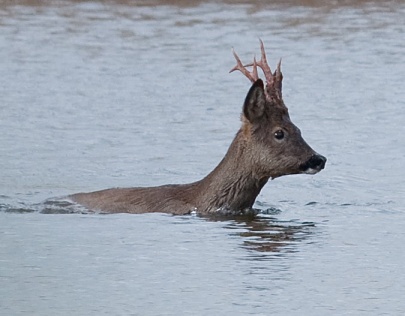
SUNDAY
OCTOBER 21 - 2018
Nore
Barn
I visited Nore
Barn at about 12.30 for my daily check for Spotted
Redshank in the stream. I was interested to meet up
with two young ladies from the organisation called
Bird Aware Solent who had set up a telescope and a
sightings board at the end of Warblington Road.
According to their leaflet, Bird Aware is a
partnership of local councils and conservation bodies
around the Solent basically to help people enjoy the
birds along the coast without disturbing them. A very
worthy cause, indeed. For more information see their
web site at . . . . http://www.birdaware.org
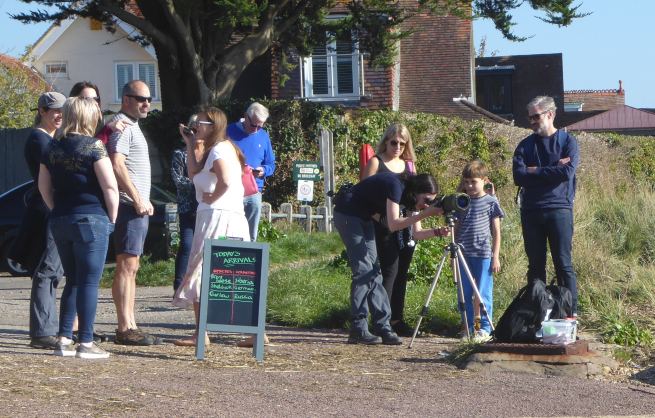
They already had Brent
Goose and Shelduck on their list, though these were
only sighted at some distance, not immediately in the
harbour. The Curlew was feeding in the bay and while
we were talking the regular colour-ringed
Greenshank (G+GL) flew onto the stream. Here it
is.
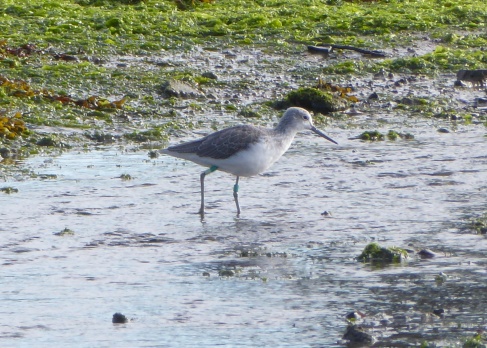
There was no sign of
the Spotted Redshank in the 30 mins or so that I was
there. I am getting a little concerned for this famous
bird which has been wintering at Nore Barn for the
past 14 years, though I have not given up hope, not by
any means! My first sighting last year was on Oct 22
which was the latest ever, so with global warming and
all that it would not be surprising for the bird to
have lingered longer than usual on the way back from
its breeding grounds in Northern Scandinavia.
For the history of
this famous Emsworth bird go to . . . Spotted
Redshanks at Nore Barn
Emsworth
Harbour
During a walk
round the town millpond this afternoon at low water, I
spotted a few waders feeding in the low water channel
in the harbour. There were at least two Greenshank:
one ringed with what looked like G+BY and one
unringed. I had a few sightings of a Greenshank with
this combination in Aug and Oct 2014 in Emsworth
Harbour, but none since then. I have asked Anne de
Potier who manages the colour-ringed Greenshank
records to confirm this for me. Late News: Anne
confirmed it as G+BY - last recorded by her on 28
August.
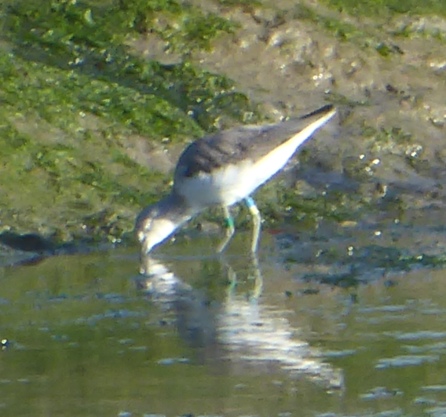
The unringed
Greenshank was feeding nearby with a Common
Redshank.

Pretty
fungi
Chris Oakley
found hundreds of these delicate fungi growing beneath
the canopy of a Beech tree on the corner of Nursery
Close in North Emsworth. This is the first time Chris
has seen them. He wonders if anyone can tell him what
they are. They look like one of the Bell Caps (Mycena)
to me, but that's as far as I can go.
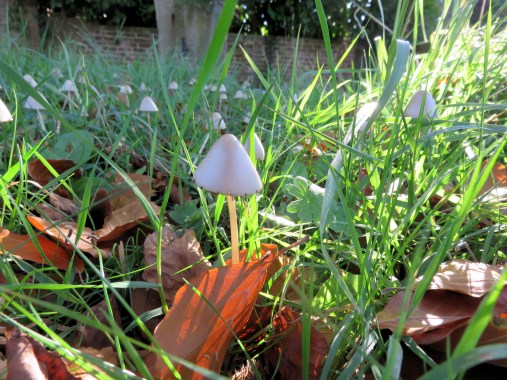
Chris adds that this
is a plot that used to be one of the 'Emsworth
Waysides' but seems to have been abandoned as it was
not touched this year, perhaps for the better. 'fraid
so Chris.
SATURDAY
OCTOBER 19 - 2018
Petworth
Park
Steph Dale
reported on this morning's walk by the Havant Wildlife
Group
A
happy group of 9 of us met in the Petworth Park car
park on a lovely warm sunny autumn morning to see the
fallow deer rut. Initially we saw some groups of does
with one or two accompanying stags and heard a little
of the bellowing made by stags but later, after our
coffee break, we walked along another valley and saw
more dramatic behaviour with stags being displaced
from their harems by more aggressive stags. We watched
one group for some time as they were quite close to
us.
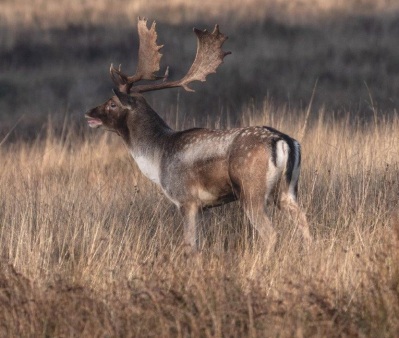
Further
on we saw a large group of deer under a stand of
trees. This group seemed to contain as many stags as
does and it was a very dynamic situation with pairs of
stags fighting, clashing antlers and then carrying out
the parallel walk. Often there was more than one pair
clashing at a time so it was fascinating to
watch.

There
was a lot of noisy bellowing from the stags.
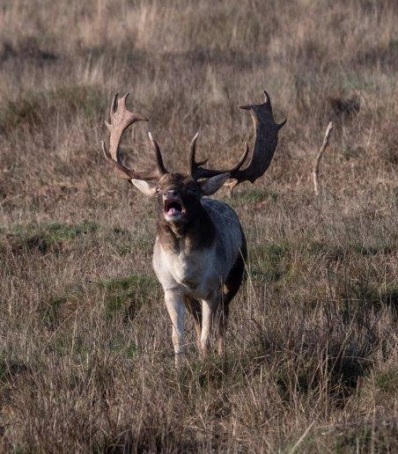
Having
now read the information on the British Deer Society
website I think that this latter group were a 'lek'.
See . . . https://www.bds.org.uk/index.php/advice-education/species/fallow-deer
The colour variation in the deer's coats was marked
ranging from dark to very pale (almost white), with
others having the expected golden coat with pale
spots.
We
talked about delayed implantation which occurs in roe
deer to avoid the fawns being born in the winter. See
. . . https://www.bds.org.uk/index.php/advice-education/species/roe-deer
Our
coffee break was spent sitting in hot sunshine on
stone benches on top of the boathouse overlooking the
large lake. From this vantage point we saw, on the
water, Canada geese, greylag geese, pochards, tufted
ducks, coots, mallard and gadwalls. Several Egyptian
geese flew over as did cormorants. Elsewhere on our
walk we saw a large flock of goldfinches, great tits,
jays, a kestrel, meadow pipits and Caroline drew our
attention to the song of the woodlark.
We all enjoyed our walk on a beautiful sunny autumn
morning. Thank you all for your company. The lovely
pictures are courtesy of Tony W.
THURSDAY
OCTOBER 18 - 2018
Brook
Meadow Work session
A good bunch
of volunteers turned out on this fine and sunny autumn
morning for some hard work on the meadow.

Leader Colin
Brotherston outlined the main tasks which were to
finish clearing arisings from the Lumley area and to
cut and clear the main orchid area for the second
time!
Dan continued to
supervise the clearance of the river bank by the north
bridge in preparation for the soil filled Hessian bags
- a long slow task. Meanwhile, Jennifer and Tony got
into the river to clear out a mountain of branches and
twigs that were blocking the flow.
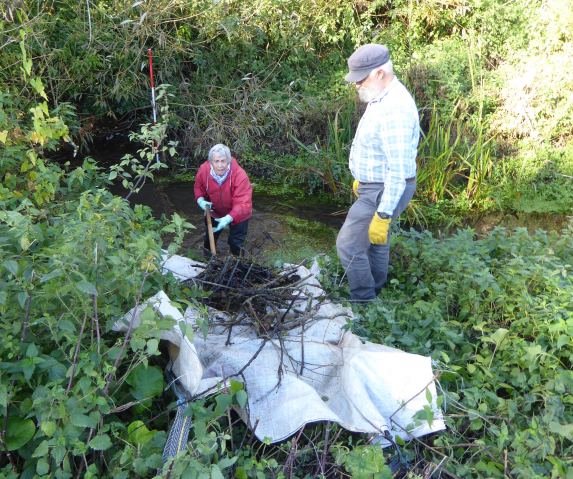
For a fuller report
and more photos of the work session go to . . .
https://www.brookmeadow.org.uk/conservation-news/
Wildlife
observations
There was
nothing special to report on the wildlife front. The
yellow flowers of Common Fleabane and Hoary Ragwort
are still brightening up the scene. I noticed a number
of grasses reflowering including False Oat-grass
(lots), Cocksfoot, Tall Fescue, Perennial Ryegrass and
a solitary Yorkshire Fog.
A 4-spot Spider was on
its web near the main river path when a small fly was
trapped the web and quickly wrapped up.
You can't see its spots in the photo, but its rounded
abdomen gives it away

WEDNESDAY
OCTOBER 17 - 2018
Bracket
Fungus
Sue Thomas
showed the bracket fungus with the etching of Swallows
from yesterday's blog to her son in law as he has used
this fungus when doing his Bushcraft courses to make
fire in a traditional way. "He makes a spark, possibly
from flints. The fungus catches the spark and then is
placed into a bundle of tinder he has collected in the
woodlands to create the beginnings of his fire. Hard
work!" Does anyone still use it for etching?
News
from Cuba
Malcolm
Phillips ex-Brook Meadow now resides in Cuba, but
still sends us his cracking photos.
Today he says weather has changed in Cuba and they are
getting rain - good for the garden. Malcolm also says
the migrant birds are starting to arrive and they had
their first warbler for some time - see photo.
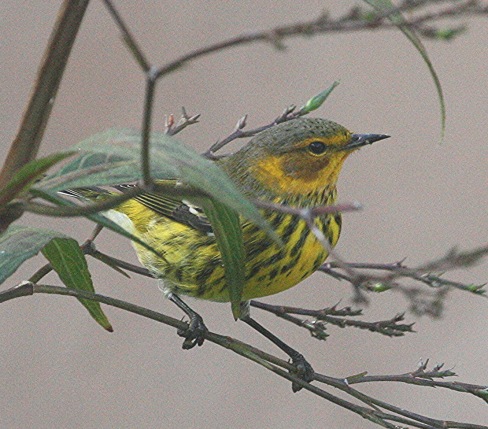
I think this is a male
Cape May Warbler - the chestnut ear patch and
tiger striped underparts are distinctive. Its breeding
grounds are in black spruce forests in Eastern Canada.
It winters chiefly in the West Indies.
Malcolm had to cut the
first bunch of bananas as it was too heavy for his
garden tree. He hung the them until they are ready to
eat, though domestic iguanas like them as his photo
shows.
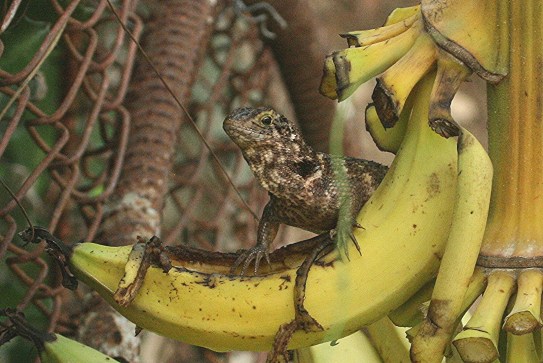
Five
Cuckoos in the Congo
The BTO
reports they now have five Cuckoos in the Congo
rainforest - Thomas from Norfolk, Robinson from
Nottingham, Bowie from Hampshire, Victor from Suffolk
and Knepp from Sussex.
Cuckoo Sherwood who has spent a few weeks near Dakar
in Senegal left that location on 2nd October and has
since covered 1,300 miles, flying east, first to The
Gambia, then on to his current location in Benin, via
Burkina Faso.
We've been tracking Lancashire Cuckoo Larry since June
2015 but we haven't received an update from his tag
for almost two weeks, when he flew from Chad into
Central African Republic. He usually winters in
northern Angola and in 2016 he moved south into the
Congo basin on 29 Sept. However, in 2017 he didn't
leave until 9 November. It will be interesting to see
what he does this year.
Keep an eye on the Cuckoo-tracking pages for the
latest updates as the birds move down into their
wintering areas. . . . at https://bto-enews.org/IG4-5WRLN-3RN36S-3BK990-0/c.aspx
TUESDAY
OCTOBER 16 - 2018
Nore
Barn
I went over to
Nore Barn at 2.30pm for the rising tide. The water was
fairly high and the stream filling. The only birds in
the stream as before were the colour-ringed Greenshank
and a Common Redshank. Still no sign of the Spotted
Redshank.
While strolling
through the woods I spotted an interesting bracket
fungus growing on a dead Oak tree. Its fruiting body
was very hard, wooden to the touch, and coloured brown
on top and pure white underneath. I think it could be
Ganoderma applantum - so called Artist's
Fungus. It grows on several hardwood trees, including
Oak.
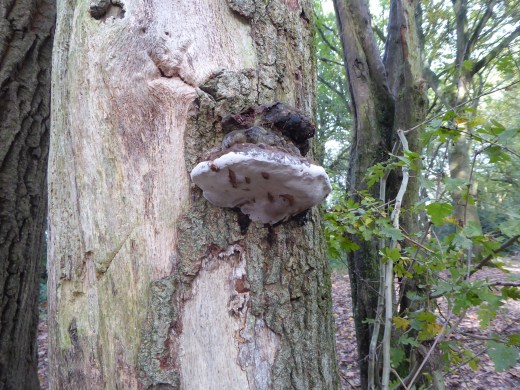
A peculiarity of this
fungus is that it can be used as a drawing medium for
artists. When the fresh white pore underside is
scratched with a sharp implement the dark brown tissue
underneath is revealed resulting in visible lines and
shading that become permanent once the fungus is dead.
There are several images of art using this technique
on the internet.
For example, Marie
Heerkens has made fungal art her speciality and an
account of her work can be found at . . .
https://www.lifeinthefingerlakes.com/marie-heerkens-fungi-artist/
Here is a
particularly beautiful picture drawn by Marie Heerkens
on this type of fungus.
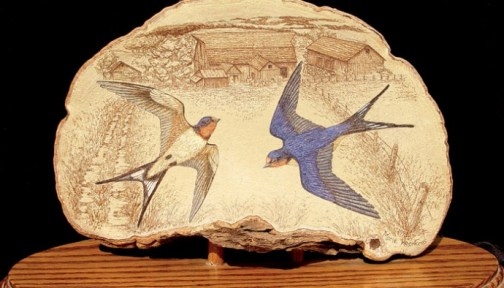
I would be interested
to hear from anyone who has used this method.
MONDAY
OCTOBER 15 - 2018
Emsworth
Harbour
I went for a
constitutional walk round the millpond this morning
listening to Beethoven's 5th on my iPhone - stirring
stuff! Nothing of interest on the pond. From the
seawall I could just see about 50 Black-tailed
Godwits roosting on the edge of the main channel -
too far out to see any rings. The regular
colour-ringed Greenshank RG+BY was feeding in
the low water channel near the quay, close enough for
a quick photo - in pensive mood. It was ringed
13-Mar-2013 by Pete Potts and his team and has been a
regular wintering bird in Emsworth Harbour since then.
This was my third sighting this season. I think we
should be getting some geolocator results on this bird
soon which should tell us where it goes in the
summer.
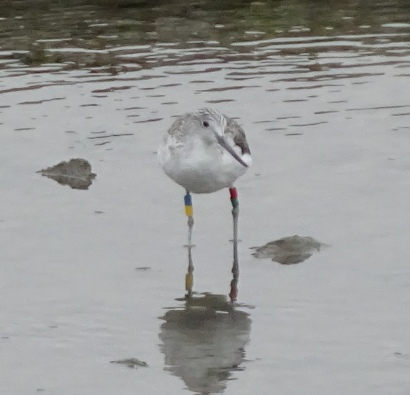
Nore
Barn
13.30 - I
spent 45 mins at Nore Barn this afternoon watching a
falling tide and hoping for Spotted Redshank, but
nothing transpired. However, the weather was fine and
warm and I was pleased to just hang around, listening
to the triple calls of Greenshank which constantly
echoed across the water. I could see at least two
Greenshank out in the main bay along with 20+ Redshank
and 44 Black-tailed Godwits.
In the stream area a Cormorant came and went. When I
left at about 14.15 the regular colour-ringed
Greenshank (G+GL) was feeding in the stream along with
a Common Redshank, but no Spotted Redshank as yet,
though there is still time!
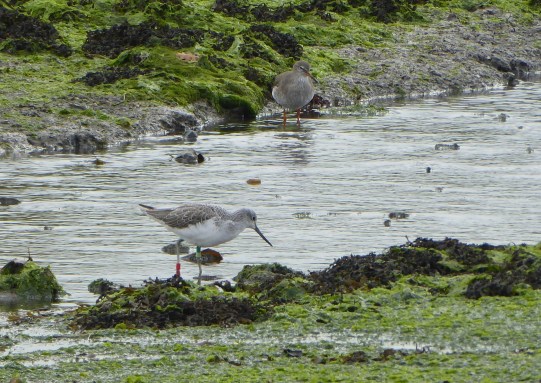
Warblington
shore
With
Wellington boots on for the first time in six months,
Peter Milinets-Raby visited the Warblington shore this
morning after a night of rain and north winds. The
birds of note were as follows.
Ibis field: Cetti's Warbler heard singing from the
rear of the field. 2 Song Thrush and 6+ Blackbirds
feeding on berries. 1 Grey Wagtail, 3 Pied Wagtail
over. 5 to 10+ Skylarks over. 1 Meadow Pipit over. 1
female Pheasant. 1 Peregrine dashed over. It had a
primary missing from its right wing.
Mini reed bed behind Conigar Point: 1 Water Rail heard
and 1 Cetti's Warbler in the Tamarisk hedge.
Conigar Point: 16 Grey Plover. 3 Dunlin. 3 Wigeon. 2
Teal. 2 Shelduck. 1 Greenshank. 1 lone adult Brent
Goose flew west along the Sweare Deep channel and
landed on the mud by the Langstone bridge. One goose
doesn't make a winter, but read on . . . .
Off Pook Lane : 7 Bar -tailed Godwit. 3 Greenshank
(G//R + LO//-). 7 Grey Plover. 2 Sandwich Tern. 4
Dunlin. 1 Meadow Pipit.
And to confirm the approach of winter a flock of 24
Brent Geese flew west along the Sweare Deep
channel circled around as if they were going to land,
then decided not to and flew off into Langstone
Harbour.
Note
from Brian: I caught the fast cat ferry over to
the Isle of Wight yesterday and saw my first flock of
Brent Geese of the year - around 250 of them feeding
on Ryde shore near the pier.
Peter sent a
photo of a Magpie Inkcap fungus that he came
across during his walk
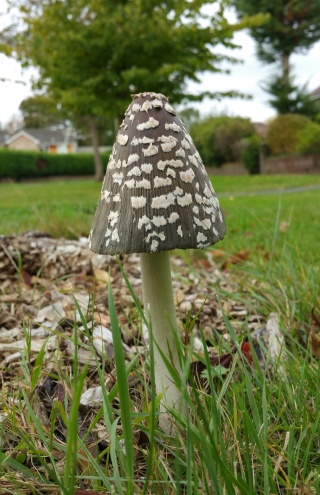
See below for another one found by Jill Stanley in
Stansted.
Fungi
in Stansted
Jill Stanley
was in the Lady's Walk area in Stansted Forest, on
Saturday (Oct 13) where she found a good showing of
fungi, including Magpie Inkcap and Porcelain
fungus. Thanks Jill for your cracking images.
Jill also saw a few
Fly Agarics which usually favour Birch woods;
Lady's Walk is mostly Beech and Oak.
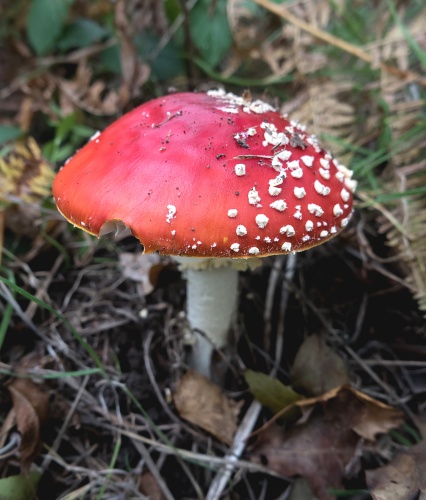
SATURDAY
OCTOBER 13 - 2018
Stansted
Forest
Jean and I
enjoyed a short walk in the Stansted Estate on this
wonderfully warm autumn day. After having coffee and
cake in the Pavilion Cafe we walked in front of the
house along a newly laid gravel path (which was not
easy walking) and turned left on the tarmac road
before turning right up the footpath alongside Ladies
Walk which appears to be closed for maintenance.
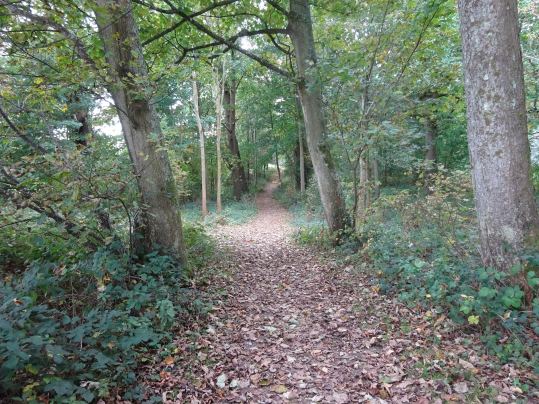
It was good to see the
magnificent ancient Sweet Chestnut trees alongside
this path.
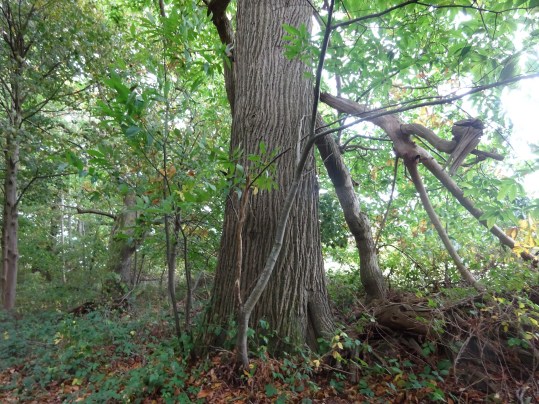
with masses of nuts
carpeting the ground beneath them. An amazing
crop!
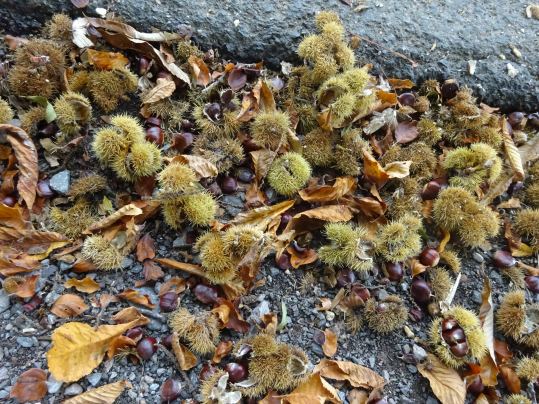
We also noted the
nascent male catkins on Hazel bushes, later to become
yellow as the flowers open in the spring.
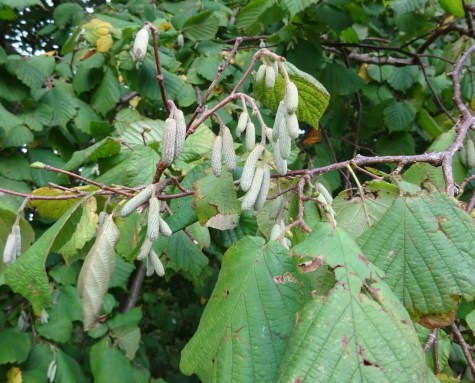
FRIDAY
OCTOBER 12 - 2018
Nore
Barn
I popped over
to Nore Barn at about 11.45 to catch the falling tide.
It was incredibly windy with the wind coming straight
off the sea, so no escaping it. I got my scope out to
go through a flock of 55 Black-tailed Godwits at the
head of the stream, but I could not see any
colour-rings among them, though many were up to their
bellies in water.

Here is a view of a
few of the Godwits through the scope.
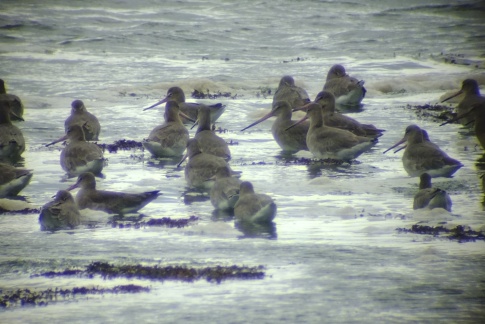
I found another flock
of 76 Black-tailed Godwits sheltering in the creek
south of the woods making a grand total of 131 which
is my best count of the winter season so far. Peter
Milinets-Raby had 126 here on Oct 3rd.
Greenshank (G+GL)
and a Common Redshank were in the stream, but still no
Spotted Redshank.
No
Hedgehog
I put the food
tray in front of the house last night where I caught
two Hedgehogs on Oct 4th, but the trail camera only
picked up a neighbour's cat helping itself to the
food! No sign of Hedgehog; just hope it is OK. I will
revert to putting the tray on the patio at the back of
the house tonight.

I spoke to my friend
Brian Picknett at table tennis this afternoon who told
me he regularly gets 4 or 5 Hedgehogs in his garden in
Church Path in the centre of Emsworth. He showed me
photos of at least 3 together taken in daylight! He
puts out mealworms for them which clearly do the
trick, though I gather they are not all that good for
Hedgehogs. I keep them to a sprinkling.
THURSDAY
OCTOBER 11 - 2018
Swan
news
Regarding the
attack on one of the Peter Pond cygnets last weekend
witnessed by Dan Mortimer (see blog for (Tue Oct 9),
Chris Oakley reports seeing both adult Swans and their
three cygnets on Sunday morning (Oct 7) during a walk
around Slipper Mill pond. Chris said 'the pen took the
three youngsters across the path into Dolphin creek
leaving the cob behind. The cob looked concerned
swimming up and down seemingly unsure where the others
had gone. It is possible that the youngsters could
have gone out into the harbour from Dolphin
creek.'
It is good to hear that the family with 3 cygnets was
intact on Sunday. I agree with Chris. Young swans
often decide to make their own way in the world at
about this time, or sometimes are driven off by their
parents. So, maybe that cygnet survived the attack?
Cuban
butterflies
Malcolm
Phillips (formerly of Brook Meadow) now lives in Cuba
but is still wielding his trusty camera at wildlife,
though his attempts to send them to me are frequently
thwarted by poor internet connexions. However, here is
a photo that did get through of two butterflies
apparently mating. Malcolm took this shot last weekend
while walking in the grounds of a hotel. He says they
found lots of butterflies in groups, not seen it
before.
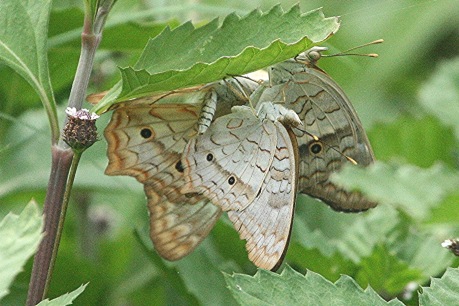
I found Malcolm's
butterflies fairly easily on the excellent Butterflies
of Cuba web site as White Peacocks - Anartia
jatrophae. They are widespread and often abundant in
open grassy habitats. Can be the most numerous species
present. Range from southern USA to Argentina and
throughout the Caribbean. See . . . http://www.butterfliesofcuba.com
WEDNESDAY
OCTOBER 10 - 2018
Warblington
shore
Peter
Milinets-Raby visited the Warblington shore this
morning ahead of an incoming tide - 9am to 10:47am. It
clearly felt like winter is still weeks away, with no
real change noted.
Off Pook Lane: 7 Grey Plover, 6 Greenshank (RG//- +
YY//- & B//R + LO//- & G//R + YN//- &
NR//- + YY//-). Only one of these birds (B//R + LO//-)
has been reported at the Northney roost by Anne. 34
Teal. 1 Shelduck, 2 Bar-tailed Godwit, 19 Dunlin, 1
Lapwing, 82+ Redshank, 1 Black-tailed Godwit, 3 Grey
Heron on marsh, 2 to 11+ Skylark over, 2 male
Stonechat perched in the main hedge, 2 Canada Geese
flew west along the channel, 1 Reed Bunting heard
flying over, 18 Sandwich Tern roosting on the last bit
of mud.
Conigar Point: 19 Teal, 6 to 15+ Meadow Pipits passing
over, 2 Pied Wagtails over north, 2 Stock Doves, 1
female Stonechat in the SSSI field.
TUESDAY
OCTOBER 9 - 2018
Swan
News
It was a
lovely autumn day for my morning walk through Brook
Meadow to the Hermitage Millponds. I found one adult
Swan on the water on Peter Pond and another adult
(presumably its mate) on Slipper Millpond near the
Hermitage Bridge with one cygnet.
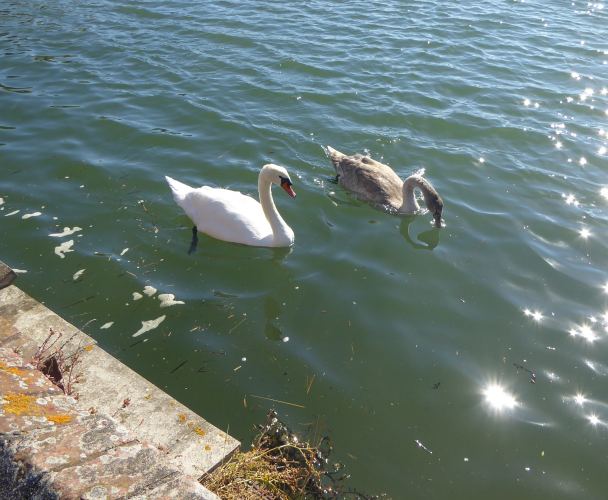
On the way up Lumley
Road I met Dan Mortimer whose house overlooks Peter
Pond and he told me about a violent skirmish in which,
what he assumed was, an intruding Mute Swan attacked
and seemingly drowned one of the cygnets though he had
not seen any corpse. My last sighting of the Slipper
Millpond swan family was on Sep 17 when three cygnets
were with their parents, so maybe the family is now
down to one cygnet following the attack. I have asked
Dan to keep a look out for any other cygnets.
This is the swan pair that nested in the reeds on
Peter Pond and produced 4 cygnets at the beginning of
June after having their first nest on the island with
8 eggs in it washed away by the high tide.
Other
news
The heavy dew
this morning created a fine spectacle of spider orb
webs in the garden. Here is a particularly fine one at
the end the garden.
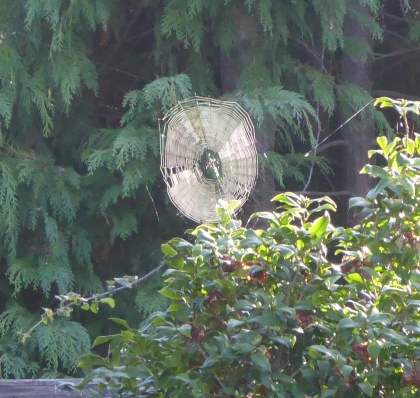
I had the fleeting
pleasure of seeing the blue flash of a
Kingfisher as it speed down the Lumley Stream.
No chance of a photo, of course, but here is one that
Malcolm Phillips got in flight over Peter Pond a
couple of years ago.
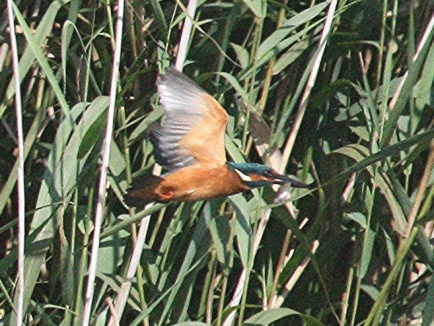
I had a nice chat with
a young lady on the bridge overlooking Peter Pond who
said she reads my blog (!). We watched shoals of large
and small Grey Mullet brought in by the high
tide while discussing the plight of the planet in view
of global warming. She has become a vegan as one small
step in combating this threat to our world.
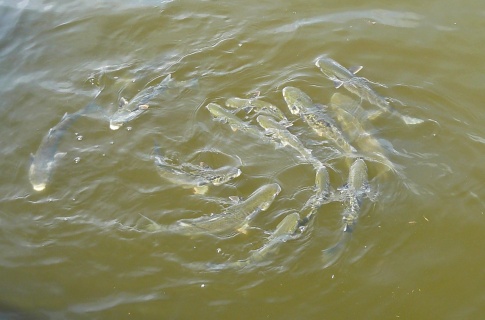
While I was chatting
with Dan a male Brimstone flew past - the second I
have seen in the past two days. This will be the
summer brood, feeding in preparation for hibernation.
The only other butterfly I saw was a Small
White on the bank of Michaelmas Daisies to the
south of Gooseberry Cottage. Keep a look out for more
butterflies on this excellent array of flowers.

This is also a good
time for dragonflies. I saw two today: a male
Common Darter resting on the Lumley Path bridge
north of Peter Pond and what I think was a Southern
Hawker though it did not stop for close examination.
Here is the darter.
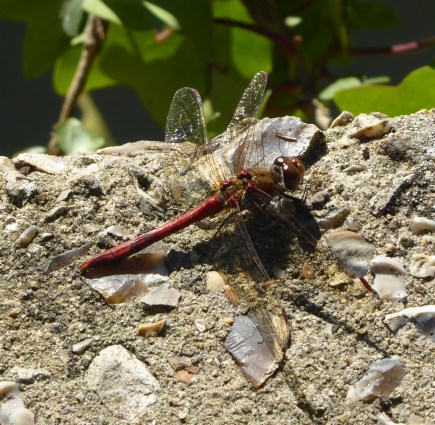
SUNDAY
OCTOBER 7 - 2018
Brook
Meadow
I went over to
the meadow this morning for the regular 1st Sunday in
the month work session. It was a lovely warm autumn
day and 11 volunteers assembled at the tool store for
work.
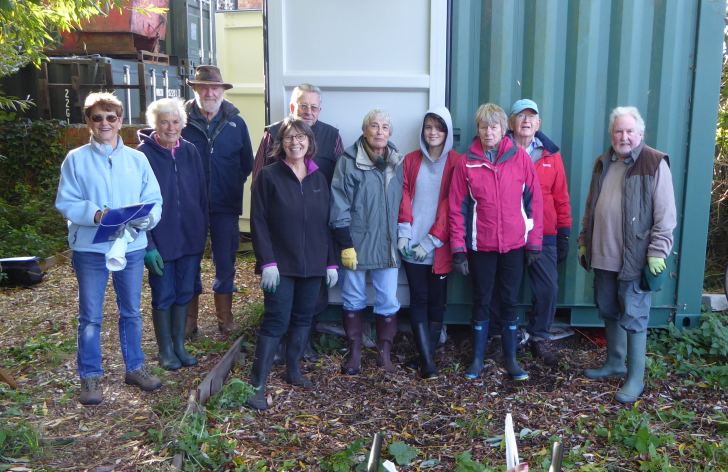
The main task of the
day outlined by Jennifer Rye was to cut and clear the
flower-rich Lumley area.
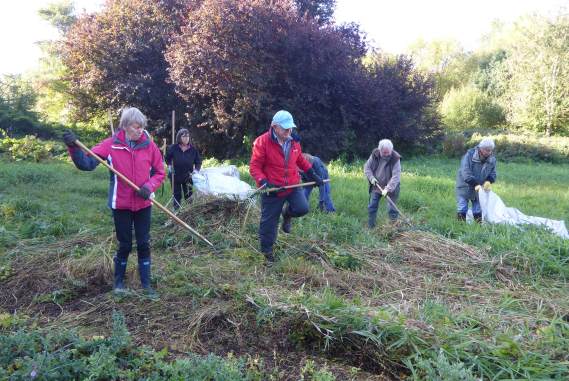
Jennifer's full report
plus more photos will shortly appear on the Brook
Meadow web site at . . . https://www.brookmeadow.org.uk/conservation-news/
Wildlife
observations during the work session
During the
cutting of the dense vegetation on the Lumley area a
young self-seeded Alder sapling was discovered,
probably from the Alder sapling that was planted
nearby a few years ago and which has grown well. It
was decided to leave it and see how it develops.
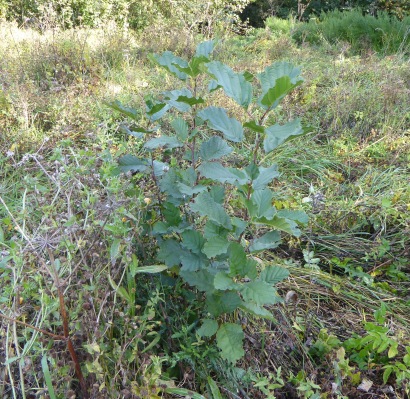
A Bumblebee with a
bright ginger thorax came to rest on the sleeve of
Martha, Jennifer's granddaughter who had come along to
help. It is probably Bombus pascuorum,
which is noted for flying late in the year.
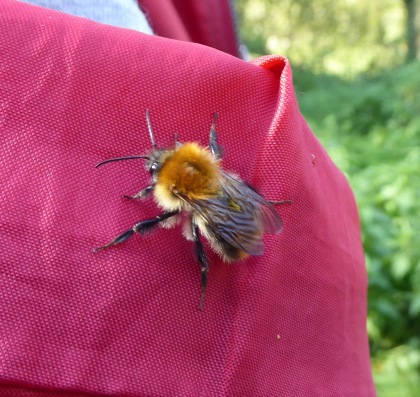
The only butterflies I
saw were Speckled Woods. I also discovered a female
Common Darter sunbathing.
I think I also had a Southern Hawker flying around me,
but it did not stop for closer study.
I noted a good number
of late flowering plants, including Common Fleabane,
Hoary Ragwort, Wild Angelica, Hogweed, Common Comfrey
(pink and white flowered), Creeping Thistle, Red
Clover, Perennial Sow-thistle and , best of all,
Meadowsweet.
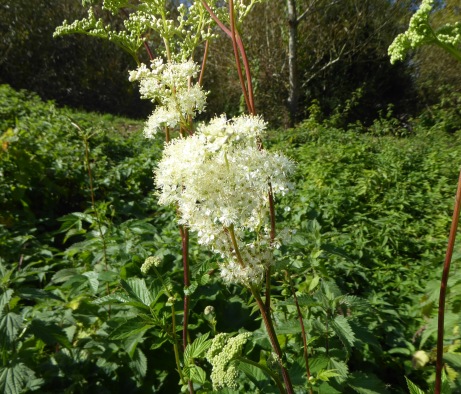
Short-eared
Owls
Carole
Checksfield was delighted to catch sight of two
Short-eared Owls hunting for food over Thorney.
Short-eared Owls are scarce passage migrants and
winter visitors to our area; Thornham Point is a good
place to see them typically flying low over the
marshes. Carole did not get a photo, so here is a
cracker of one in flight over Thorney taken by Richard
Somerscocks a few years ago.
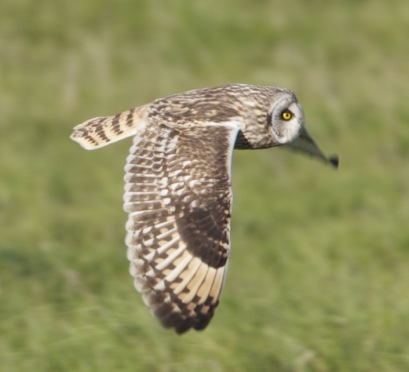
Carole also managed to
spot a Barn Owl. Several keen birdwatchers were
present and reported they had also seen two Ospreys
earlier in the afternoon in the same area. So, there's
plenty of interest at Thorney. #
Greenshank
on Thorney Island
In response to
Peter Milinets-Raby's query in Friday's blog about the
number of Greenshank roosting on Thorney Island Anne
de Potier provided the following information:
"On
the last tides I found c45 Greenshank roosting on the
eastern Deeps. There were another 15 or so roosting
east of the Marina at Northney with the Redshank on
the eastern arm of the broken ex-boating lake bank
(SU732041). The latter included some of your
Langstone/Warblington birds. Most of the Deeps birds
feed west of Thorney, but not all - a few can be found
in the Prinsted/Thornham area."
FRIDAY
OCTOBER 5 - 2018
Hedgehog
in garden
I put the food
tray on the patio at the back of the house last night.
The trail camera recorded just one Hedgehog making
four visits to feed during the night starting at 20.59
and finishing at 01.11. I had two Hedgehogs the
previous night with the tray at the front of the
house, so presumably the second one did not make it
round the back. I will try the front again tonight.
Here is a shot of
the hog when it first arrived at the tray.
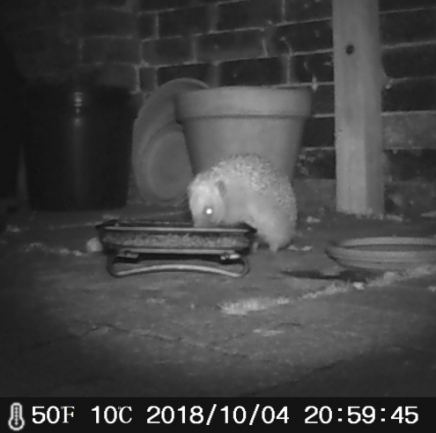
Brimstone
While taking
lunch in the garden I was delighted to have a male
Brimstone fluttering past, but not stopping. This chap
will be one of the summer brood which is likely to be
seen flying well into November. They spend their time
fattening up in preparation for hibernation - maybe
somewhere in my Ivy hedge. I did not get a photo of
the butterfly, but here is a cracking summer brood
male captured by Malcolm Phillips a couple of years
ago.
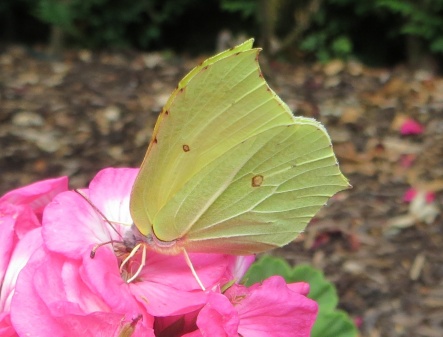
Nore
Barn
I went over to
Nore Barn at 11.30 on a falling tide to check the
stream for Spotted Redshank. I waited for about 30
mins while the stream gradually emptied of water, but
there was no sign of it. See Peter's report below who
found 8 Greenshank snoozing at Nore Barn, though they
were not in the stream while I was there!
I had a rest at
the picnic table where I amused myself taking a selfie
at the picnic table. What a nice day!

While walking around
the saltmarshes my attention was attracted by the
bright red leaves of Annual Seablite. This
plant has thick fleshy leaves which turn bright red in
autumn, rather like a Glasswort, but, unlike
Glasswort, it has twiggy stems.
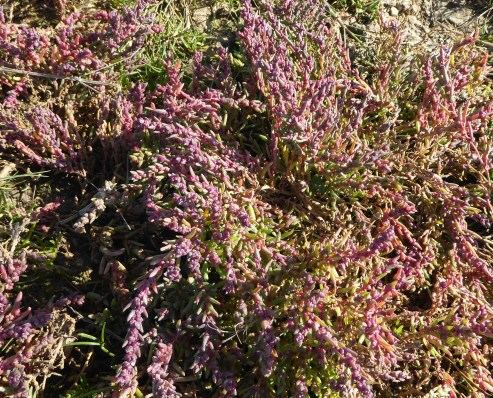
Emsworth
Harbour
Peter
Milinets-Raby spent an hour down Emsworth Harbour and
Nore Barn from 11:17am just as the tide started to
drop.
"The aim of my visit today was to try and confirm the
local distribution of the Greenshank that are present
along this shore.
As I expected the Greenshank fly from their roost on
Thorney Island onto the edge of the marsh off Nore
Barn and Beacon Square for another snooze. Why they do
this I do not know, especially having just had a high
tide roost/snooze for the past 6+hours. The Redshank
do the same , but soon feed after a 15 minute snooze.
Dunlin fly in and feed straight away, so do the
Oystercatchers.
Today there were 9 Greenshank in a snoozing group off
Beacon Square and 8 doing the same off Nore Barn.
After 25 minutes 8 birds flew off to the stream
outflow by the town in Emsworth Harbour.
This left 2 birds feeding off Beacon Square and six at
Nore Barn that were still snoozing when I left at
12:20pm. The Nore Barn stream did have some human
disturbance so this is probably the reason why the
birds were still snoozing and not feeding. I would be
interested to know the total Greenshank roosting on
Thorney Island at the moment? I assume the 4 to 8
birds usually recorded off Pook Lane are made up of
direct birds that fly from the Thorney roost and 50%
of the birds from Nore Barn that disperse as the tide
starts to come in again.
Other birds of note this morning.
Beacon Square: 8 Dunlin, 1 Grey Plover, 4 Black tailed
Godwit.
Nore Barn: 5 Shelduck.
Emsworth Harbour: 8 Black tailed Godwit, 16 Little
Egret, 6 Skylark over east.
Seen distantly over Conigar Point a flock of 100+ Teal
with 16 Wigeon amongst them.
THURSDAY
OCTOBER 4 - 2018
Two
Hedgehogs in garden
I had two
Hedgehogs in the garden for the first time since I
have been putting out food for them about a month ago.
I had put the tray in a new position on the path in
front of the house for the first time. Both Hedgehogs
arrived at 21.02 and were feeding together for about
20 mins. After that I recorded just one at the tray
until about 02.06 and no more. I assume they are a
pair fattening up for their winter hibernation, if we
get a winter that is! Tonight I will put the food tray
at the back of the house as usual.
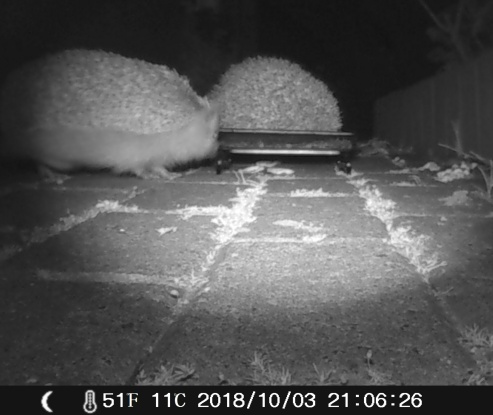
Brent
Geese are here!
Susan Kelly
saw 'several large honking groups of Brent swimming in
the harbour at high tide this misty morning, visible
from the harbour wall and the sailing club.' These are
the first Brents to be reported in Emsworth Harbour
this season - though as Susan suggested they were
probably only dropping in on their further south and
west, so may not be hanging around for long. Susan did
not get a photo, so here is one I got a few years ago
of a small flock of Brents feeding in the harbour.
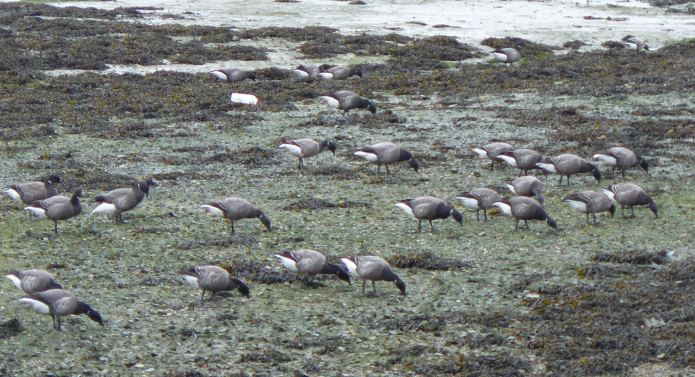
Chris Cockburn also
e-mailed me with the news of the arrival of the Brent
Geese in the Sinah Lake area of Langstone Harbour
which is where they are always seen first. Chris added
that from past experiences, he would normally expect
to see/hear the first arrivals in the harbour in
mid-Sep (often on 17th!); but given lack of NE
breezes, it is perhaps no surprise that 4th Oct is
quite a late date.
Farlington
Marshes
Christopher
Evans reports on today's walk by the Havant U3A
group
On an overcast, slightly damp day, half a dozen of us
enjoyed a successful walk around Farlington Marshes.
Species seen include Avocet, Black tailed Godwit,
Buzzard, Curlew, Dunlin, Great Crested Grebe,
Greenshank, Kestrel, Kingfisher, Lapwing, Little
Egret, Long tailed Tit, Oystercatcher, Redshank,
Shelduck, Stonechat, Teal and Wheatear. The highlight
though, was not a bird but a Weasel, which appeared on
the path ahead of us and stayed there long enough for
us to get a good view of it.
Internet
news from Ralph Hollins
Reports for
Oct 4
IOW - Redwing
9 flying NW over Bembridge
PAGHAM HBR - 11 Spotted Redshank, 60 Black Tailed
Godwit
Also 'good numbers' of Wigeon.
NORTH KENT - 710 Black Tailed Godwit with 185 Golden
Plover & 283 Curlew
Reports for Oct 3
SOS - 200 Brent in Chi Hbr off Pilsey. Red Backed
Shrike still at Thorney Deeps
Butterflies on Thorney Is - Clouded Yellow 9 Common
Blue 12 Small Copper 7 Speckled Wood 3 Small White 18
Red Admiral 6 Meadow Brown 1 Peacock 1
IOW - 24 Jay west over St Catherine's Point (after 140
west on Sep 30)
PAGHAM HBR - 1 Great White Egret 100+ Black Tailed
Godwit 10 Spotted Redshank 200 Wigeon. 6 Pintail
PORTLAND - Increase in Blackbird Passage
WEYMOUTH AREA - Black-Necked Grebe 1
POOLE HBR - Avocet 150+ (following first reports of
Autumn arrivals of 350 on Sept 30 and 85 on Sept
12)
DUNGENESS - 5000 House Martins & 2000 Swallows
Plus first Black Throated Diver
SANDWICH - 220 Siskin & first Lesser Redpoll of
autumn.
KENT - Ashford Area - Black Redstart 1 (first winter
arrival?)
WEDNESDAY
OCTOBER 3 - 2018
Spotted
Redshank?
I had an
excited e-mail from Maggie Gebbett whose house
overlooks Nore Barn to say she had seen what looked
like a Spotted Redshank feeding in the stream with the
regular colour-ringed Greenshank. I made a quick visit
to Nore Barn on my way to the Pallant Gallery in
Chichester at about 9am to check it out. It was a
truly wonderful autumn morning, with a warm sun
glinting on the receding waters of the high tide, but
I could not stay.
The regular colour-ringed Greenshank (G+GL) was
feeding busily in the stream along with, not a Spotted
Redshank but, a Common Redshank. Confusing
Common Redshank and Spotted Redshank is easy to make.
The Spotted Redshank has a much longer bill and a
clear white brow creating a distinctive face pattern;
the Common Redshank's head is plain.
Maggie later posted me
a photo of her bird - a Common Redshank. But I
encouraged her to carry on looking as it is still
early for the Spotted Redshank which did not turn up
last year until 22-Oct.
Scaup
on millpond?
Peter
Milinets-Raby is pretty sure that the small brown duck
I saw on the town millpond yesterday was a Tufted Duck
- a young female, or just a female, in eclipse
plumage. He says, the bill is not interesting enough
and the tiny crest is typical of a Tufted Duck. That's
a pity because a Scaup would be a great bird for the
area. But a good try!
Here is the
millpond duck on the left compared with a Scaup from
the internet on the right
Emsworth
Harbour
Peter
Milinets-Raby had a short visit to Emsworth Harbour
this morning for an hour from 9:07am just as the tide
was dropping.
Emsworth Harbour: 1 Peregrine over north. 5
Black-tailed Godwit, 7 Greenshank in the stream
outflow by the town wall, 1 Great Black-backed Gull, 1
Turnstone, 12 Grey Plover, 1 Dunlin, 27 Canada Geese,
5 Little Egret, 1 adult winter Med Gull, 1 Meadow
Pipit over.
Mill Pond - Just 10 Coot. No Tufted Duck (or
Scaup!)
Beacon Square: 1 Meadow Pipit over, 32 Teal, 9
Black-tailed Godwit, 11 Dunlin.
Nore Barn: 10 Greenshank (RG//- + BY//- and YO//- +
YY//-), 3 Dunlin, 126 Black-tailed Gull, 2 Teal, 3
Shelduck.
Hedgehog
in garden
The Hedgehog
visited the food tray and water bowl several times
throughout the night starting at 20.42 and finally
leaving at 05.22. Here is a shot of the Hedgehog
arriving at the food tray from the narrow passage at
the side of the house.
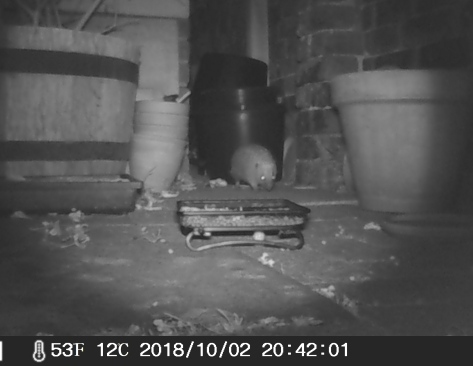
To find out more about
how the Hedgehog gets into the garden, this evening I
positioned the food tray on the path at the front of
the house where I think the Hedgehog comes with thre
trail camera focussed on it.
Internet
news from Ralph Hollins
Reports for
Oct 3
HOS - 125 COMMON GULLS & 170 GADWALL back at
Alresford Pond
HAWFINCH 1 heading south over Solent in Lymington
area
SELSEY - 9 BRENT west SWALLOW 282 east
PAGHAM - 100+ BLACK-TAILED GODWIT 10 SPOTTED REDSHANK
200+ WIGEON. Many TEAL
Isle of Wight - RING OUZEL 1 on West High Down
BEACHY HEAD - 10 immigrant ROBINS
KENT - 1 BRAMBLING in off at Dover 20+ RUFF at Oare
Marshes near Faversham
Reports for Oct 2
SELSEY - SWALLOW 320 east
PORTLAND - 36 BRENT east
DORSET - BLACK-NECKED GREBE 4 at Studland Bay
RYE Hampshire Bird Report - ANT behaviour with HOLLY
BLUE caterpillar - see
http://www.rxwildlife.info/sightings/2018/10/2/the-holly-blue-and-the-ivy.html
TUESDAY
OCTOBER 2 - 2018
Scaup
on millpond?
While walking
around Emsworth Millpond this morning I happened to
meet my friend Susan Kelly who drew my attention to
the presence of a small brown diving duck on the pond.
I thought it most likely to be a Tufted Duck which we
have had recently on the pond. However, it was on its
own, which is unusual for Tufted Duck, and this made
me consider the possibility of a Scaup. Features
supporting this ID were the high rounded crown with no
hint of a tuft and the light patch above the bill.
Here is a video clip
of the duck . . . . https://youtu.be/ZZOzL3ZSNe4
For comparison
here are 6 juvenile Tufted Duck on Emsworth Millpond
taken on 04-Sep-18
It could have been one of these.
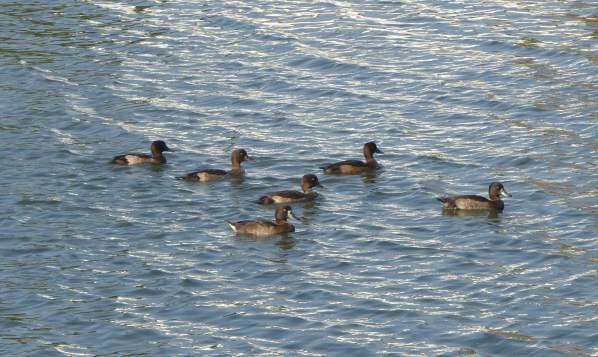
Waders
by the quay
There were
several waders feeding in the low water channel near
the quay. In addition to the regular Little Egret
there were two Greenshanks, one of which was
colour-ringed RG+BY.

Greenshank RG+BY has
been seen many times in Emsworth Harbour since its
ringing by Pete Potts and his team on 19-Mar-2013.
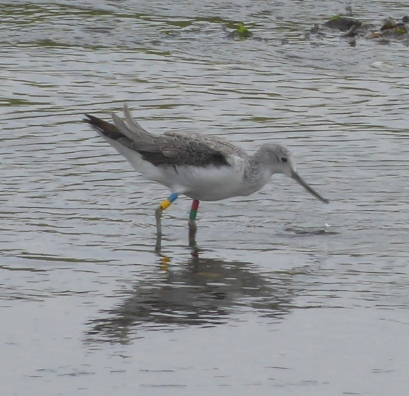
Also feeding in the
channel was a juvenile Black-tailed Godwit -
distinguished by its scaly looking wings.

Hedgehog
in garden
Last night I
placed the food tray with hog food and mealworms plus
the bowl of water close to the passage by the side of
the house to check where the Hedgehog comes into the
garden. This confirmed that the Hedgehog does come
into the garden this way. It visited the food station
as usual several times in the night, eating all the
mealworms and most of the standard hog food and taking
sips of water on at least three occasions. A cat was
also hanging around from time to time.
Hedgehog taking a
sip of water
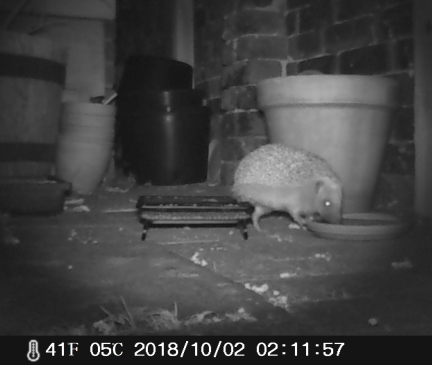
News
from Ralph
More snippets
of recent bird news gleaned from the internet by Ralph
Hollins
BROWN SHRIKE 1 at Lizard see . . . https://en.wikipedia.org/wiki/Brown_shrike
DARK BRENT 3 west and a second SNOW BUNTING arrives
Whitstable area
WIGEON 200 & GREAT WHITE EGRET 1 - Pagham harbour
since Sep 30
HOUSE MARTIN 400 west - Rye area
REDWING 2 & HOUSE MARTIN 300 - Shanklin area
REDWING 1 & REED BUNTING 2 - Folkestone area
REDWING 4 first Dungeness
REDWING 1 Weymouth area
RED-BACKED SHRIKE still at Thorney Deeps
DIPPER at Avonwick RING OUZEL 6 on Dartmoor
RED BACKED SHRIKE on north side of Thorney
JAY up to 140 flying west over West High Down Isle of
Wight
WRYNECK and TURTLE DOVE - Portland
MONDAY
OCTOBER 1 - 2018
Nore
Barn
I nipped over
to Nore Barn in the car after lunch just in time for
the rising tide and the stream was pretty full
already. The only bird of interest was the regular
colour-ringed Greenshank G+GL on the edge of the
saltmarshes - waiting patiently for its regular
feeding comanion to arrive. But no sign as yet of the
Spotted Redshank.
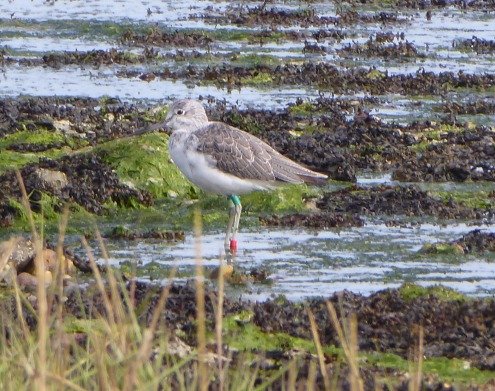
I noted
Butcher's-broom flowers just opening on the south
path.
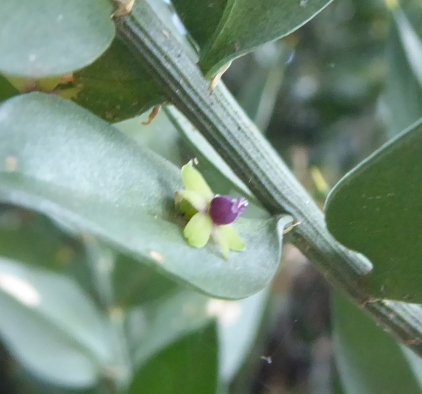
Hedgehog
in garden
I put the food
tray with hog food and a sprinkling of mealworms on
the patio last night. Most of it had gone by this
morning. The trail camera caught the Hedgehog visiting
several times in the night as usual, once watched
closely by one of the local cats. I assume a cat would
not go for a Hedgehog.
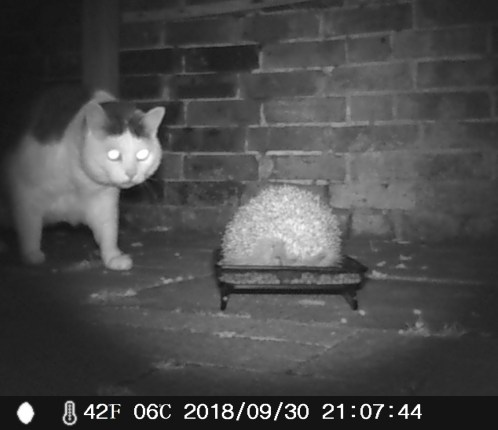
Peter's
news
Peter
Milinets-Raby was out this morning for a
'Shakespearian-esque' walk around the shore from
Emsworth to Langstone (9:07am to 11:15am - low
tide).
Beacon Square: To my surprise there was a cheap, tatty
and poorly erected tent on the muddy shore. I walked
by just as the north wind picked up and realised that
soon it would be the winter of our discount tent.
6 Teal. 3 Little Egrets. 3 Chiffchaff in the back
gardens.
Emsworth Harbour: 12 Grey Plover. 21 Black-tailed
Godwit. 12 Greenshank together in the stream outflow
by the town. 15 Turnstone. 2 Meadow Pipits over. 13
Knot (one of Shakespeare's favourite birds - To be or
Knot to be). 4 Dunlin. 1 Kestrel. 1 Kingfisher perched
on one of the boats.
Emsworth Mill Pond: 8 Coot.
Nore Barn. 3 Greenshank, 10 Shelduck, 1 Black-tailed
Godwit, 1 Skylark over.
Langstone Mill Pond: 3 Shoveler - all eclipse, 43
Teal, 1 Little Grebe, 2 Chiffchaff. 1 Cetti's Warbler
heard.
Off shore: 10 Teal, 10 Grey Plover, 61 Dunlin, 3
Bar-tailed Godwit, 16 roosting Sandwich Tern, 102
Black-tailed Godwit, 115+ Redshank, 2 Kingfishers
chasing each other, 1 Greenshank, 11 Knot.
In the distance off Conigar Point: 10 Dunlin, 2
Shelduck.
Ralph's
news
Ralph Hollins
has been combing the internet for new of migrant
birds. Here are a few of his findings
30/9 - Dark Brent Brownwich 19 Hill Head 9. Redwing 2
in New Forest & 46 Aldershot
29/9 - Redwing 3 west near Aldershot & 10 Dark
Brent near Titchfield Haven
29/9 - Portland Dark Brent 2 past
30/9 - Sandwich First Twite
29/9 - Selsey - Dark Brent 1 Dark Brent 9 off
C/Norton. 3 Black Swans at Medmerry (Active as this is
Australian spring) 11 Marsh Frogs in Severals see
http://www.herpetofauna.co.uk/marsh_frog.htm Rock
Pipits starting to appear along coast
29/9 - Beachy Head. 12 Robins on Head probably from
continent
30/9 - Devon. 25 Dark Brent at Exmouth & 14 Cattle
Egrets at Wembury
29/9 - Estonia (junction of Baltic Sea with Gulf of
Finland). 9342 Wigeon + 1180 RB Merganser.
28/9 - Estonia (junction of Baltic Sea with Gulf of
Finland) Dark Brent 5820
30/9 - North Kent Reculver see
http://reculverbirding.blogspot.com/ Redwing 2
29/9 - North Kent Reculver. Brambling 1, Snow Bunting
1
For
the previous entries go to . . September
1-30